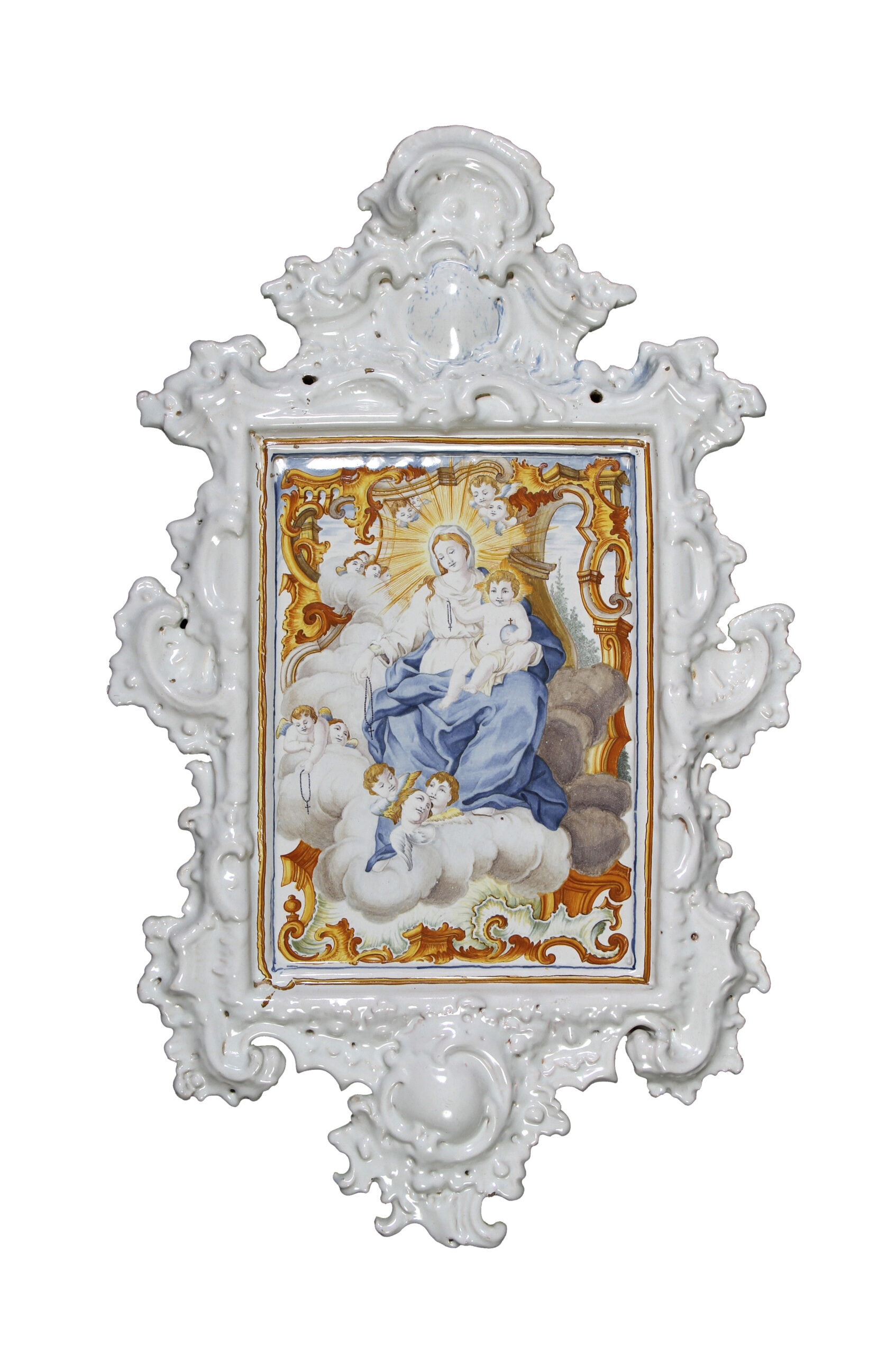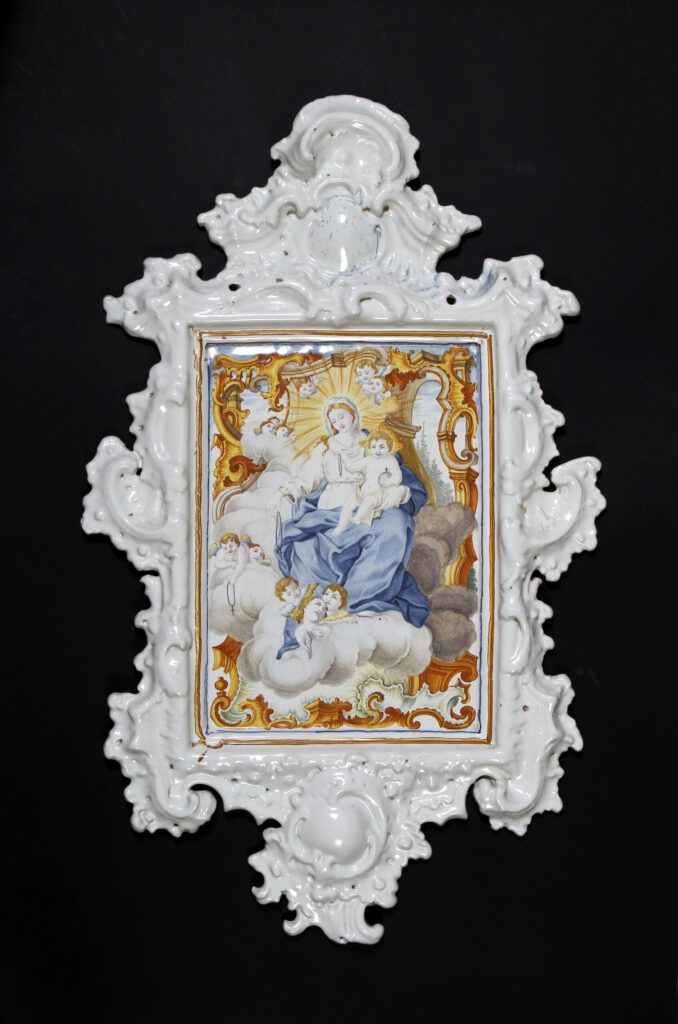
The Real Fábrica de Loza Alcora was established just north of Valencia by Buenaventura Ximénez de Urrea, Abarca de Boléa (1699-1742), the ninth Count of Aranda in 1727. The first ordinances, published in 1727, specified that an academy be established to teach apprentices between twelve and sixteen years old from the neighbouring area. This body of trained artists produced some of the finest painting on any European faience.
The Count also hired two potters from Moustiers in Southern France, Joseph Olerys (1697-1749) and Edouard Roux (1693-1749) who introduced the high qualities of glaze and body which characterise the factory. The factory was taken over in 1742 and expanded by the 10th Count of Aranda who became ambassador to France between 1773 and 1787.
We are grateful to Alexius Feit for supplying the following details and identifying the sources.
Iconographic comments on the Alcora wall-plaque « Virgin of the Rosary »
Alexius Feit
This wall-plaque was produced between 1750 and 1764, when the royal Alcora factory was under the joint artistic direction of Julián López and José Ochando. After the publication of the new factory Ordinances in July 1749 both gave new artistic impetus: José Ochando with rococo sculptural forms and Julián Lopez with rococo designs. Although Julián López assumed the artistic direction alone from 1752-1761, the rococo style was adopted by both between 1749 and 1752. This wall plaque is therefore a beautiful example of the rococo style in both the painted decoration and in the sculptural form of the frame.
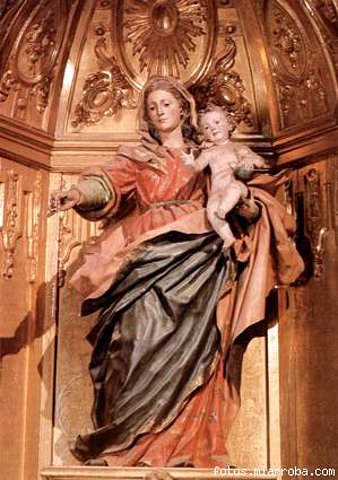
Fig. 1. Virgin of the Rosary in Santa Maria Vergara, by Luis Salvador Carmona, 1740
The Virgin of the Rosary was a standard theme in the Spanish art of the 18th century. With respect to this plaque, it was seemingly inspired by two different sculptures by Luis Salvador Carmona (1708-1767). The first is a sculpture of the Virgin of the Rosary in the church of Santa Maria de Vergara (Guipuzcua) made around 1740 (Fig. 1), where the Madonna is sculpted standing up. The second is a in the Santo Domingo el Real monastery in Madrid made around 1750 (Fig.2), where the Madonna is sitting on the clouds. It appears that the painter from Alcora was inspired by upper part of the first and the lower part of the second as models for his illustration of the Virgin of the Rosary in this wall-plaque.

Fig. 2. Virgin of the Rosary in Santo Domingo el Real, by Luis Salvador Carmona, 1750
These two sculptures executed by one of the most prestigious Spanish artists in the mid-18th century were copied in engravings, notably by Manuel Salvador Carmona (1734–1820, nephew of Luis Salvador Carmona) in the early 1750s, when he was a pupil at the Real Academia de Bellas Artes de San Fernando in Madrid before leaving for Paris. There he completed his engraver’s education in the workshop of Nicolás Gabriel Dupuis, married Margarita Legrand and returned to Spain in 1762. Even though an engraving of a Virgin of the Rosary by Manuel Salvador Carmona made in his early days is mentioned in the literature, it has until now not appeared in museums, collections, auction houses or academic institutions.
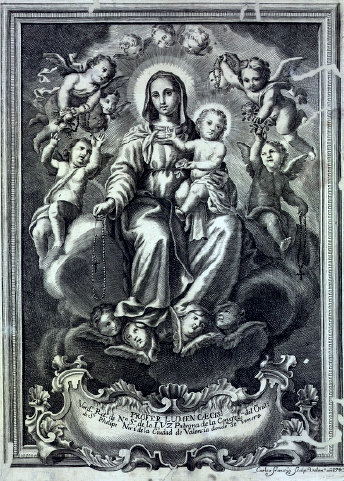
Fig. 3 Virgin of the Light, by Carlos Francia 1750
The engraving with the closest resemblance to the Carmona sculptures is a Virgin of the Light made by the Spanish engraver Carlos Francia (active 1741-1762) (Fig. 3). It illustrates the patroness of the Saint Philip Neri Congregation in the town of Valencia. This engraving made in the early 1750s has a typical rococo style frame around the inscription at the bottom. A similar engraving from Manuel Salvador Carmona shows the Virgin of Consolation, made in 1770 (Fig.4). The Carlos Francia engraving or possibly the one by Manual Salvador Carmona yet to be discovered, may well have served as inspiration for this Virgin of the Rosary wall-plaque from Alcora.
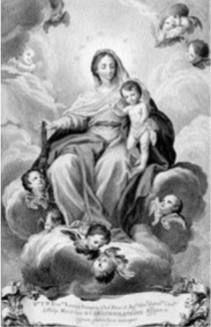
Fig. 4 Virgin of Consolation, by Manuel Salvador Carmona, 1770
Our plaque came from the collection of Professor Francis Wormald (1904-72), a palaeographer and historian, who worked in the Manuscripts Department at the British Museum and at King’s College London and for two terms at Princeton, New Jersey. He was awarded the C.B.E. for services to palaeography. He was a Fellow of Magdalene College, Cambridge, King’s College London, University of York, Pierpont Morgan Library, German Archaeological Institute, National Society of Antiquaries of France. He became Trustee of the British Museum and President of the Society of Antiquaries and Chairman of the British National Committee of Historians. He served on over 15 Councils including the Advisory Committee on the Export of Works of Art, the NACF, British Museum, the V& A and the London Museum. He was Director of the Institute of Historical Research from 1960 to1967.
Condition:
Good, no restoration
Bibliogaphy:
Alexius und Christian Feit, Spanische Fayencen 15. bis 19. Jahrhundert, (Hirmer Verlag, Munich, 2012)
Alexius Feit, Iconographie de la faïence d’Alcora 1727-1798, (e-DitARX, 2017)
Juan Carrete Parrondo, El grabado a buril en la España ilustrada: Manuel Salvador Carmona, Fábrica Nacional de Moneda y Timbre, (Madrid, 1989)
Jesús Urrea, Revisión de la vida y obra de Luis Salvador Carmona, Bol. del Seminario de Arte y Arqueología, (Valladolid, 1983), p. 441-45, Lam. II
Provenance:
Professor Francis Wormald (1904-72), bought in the 1950s or 1960s, Assistant Keeper in the Department of manuscripts, The British Museum.
Then by descent to the present owner
SOLD

